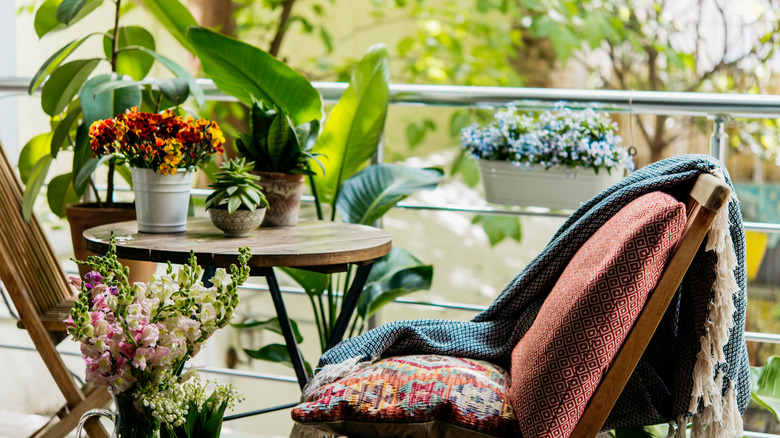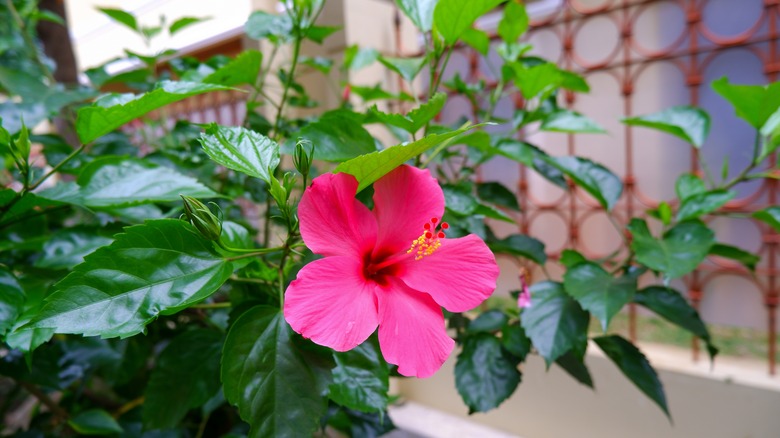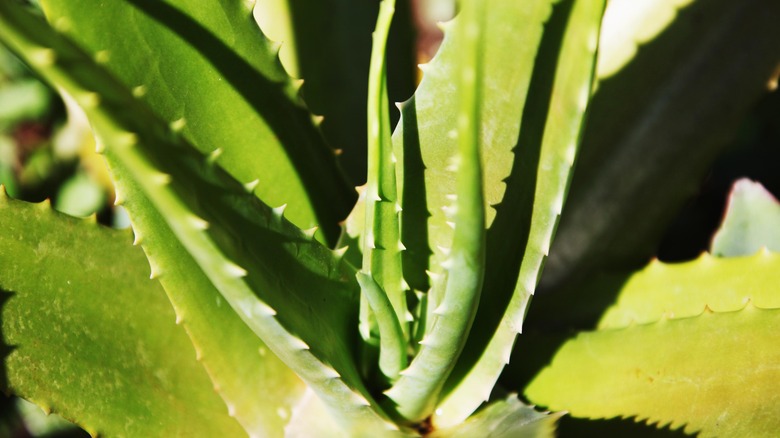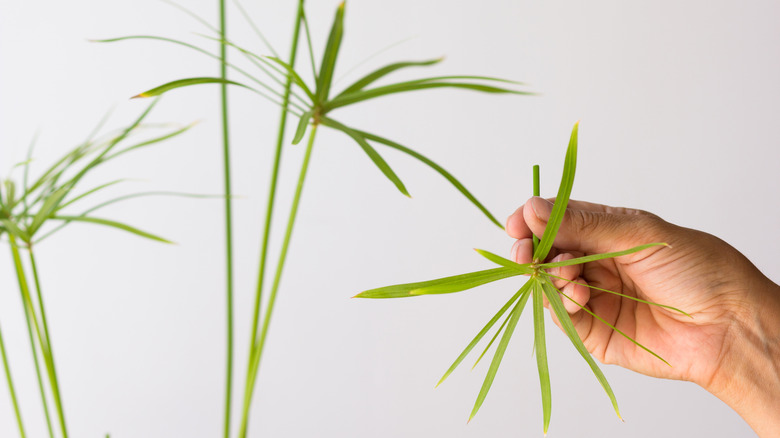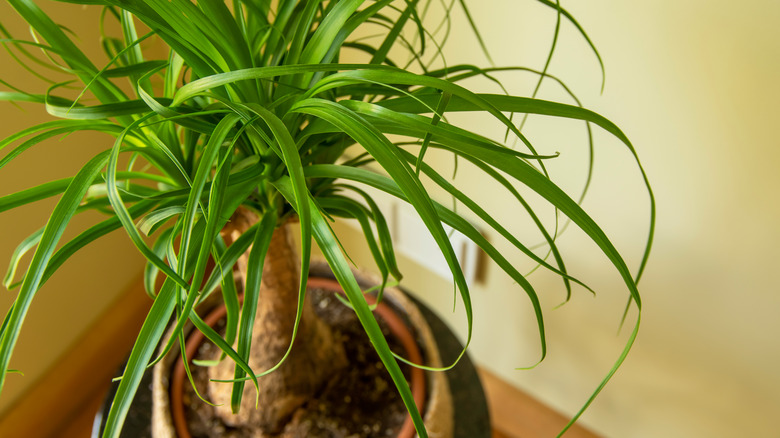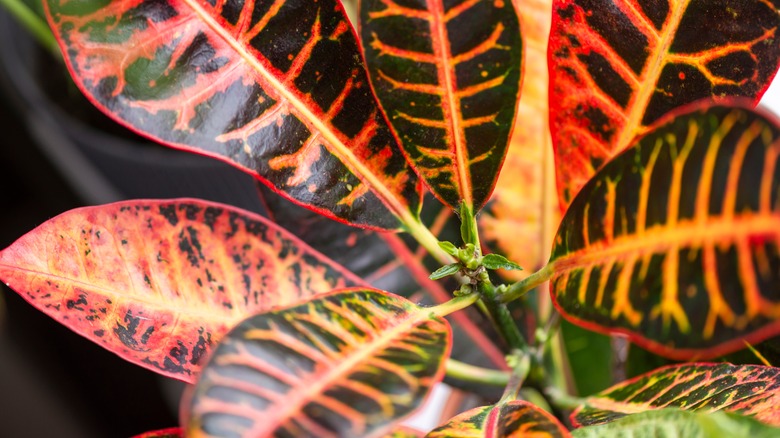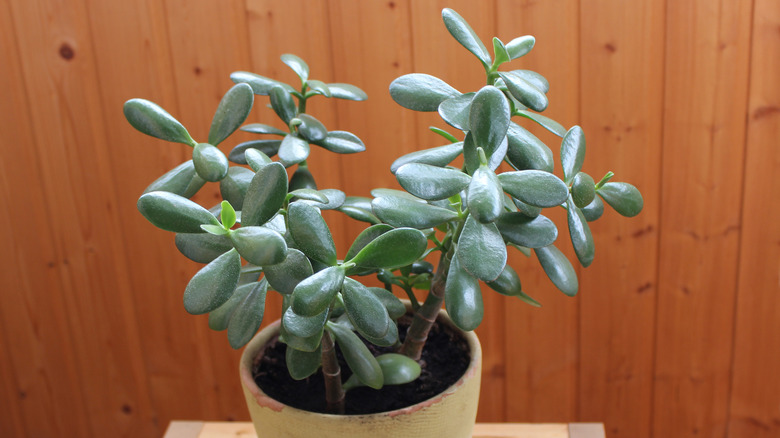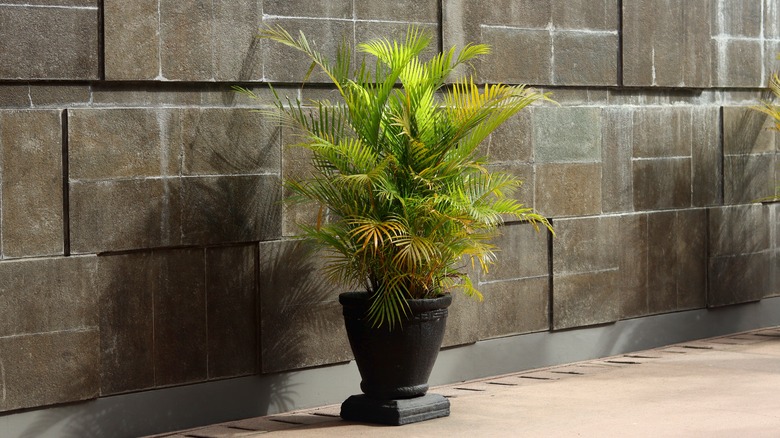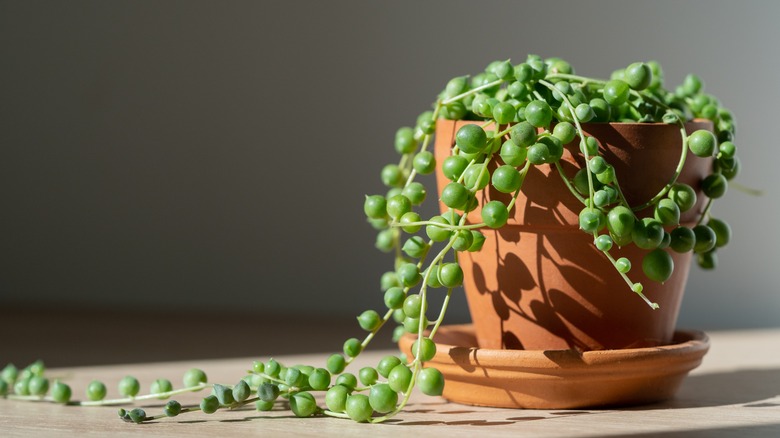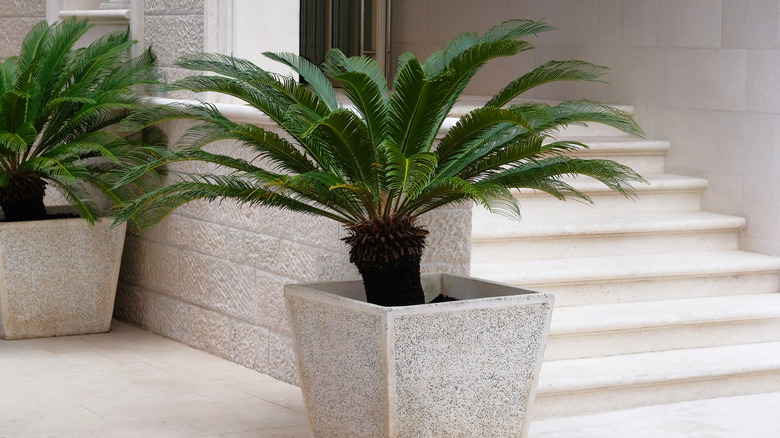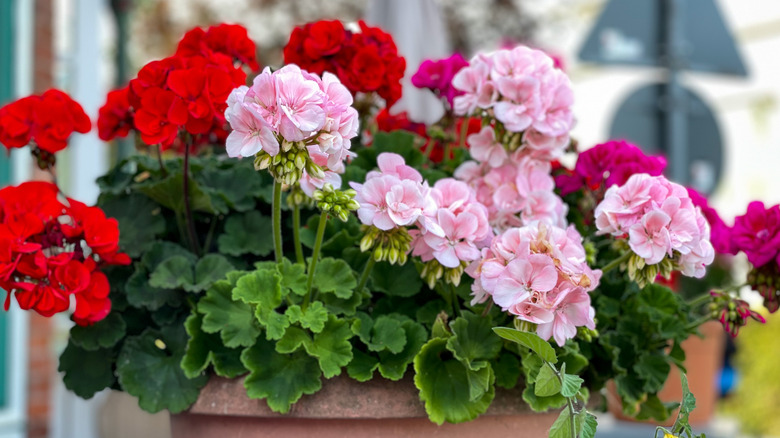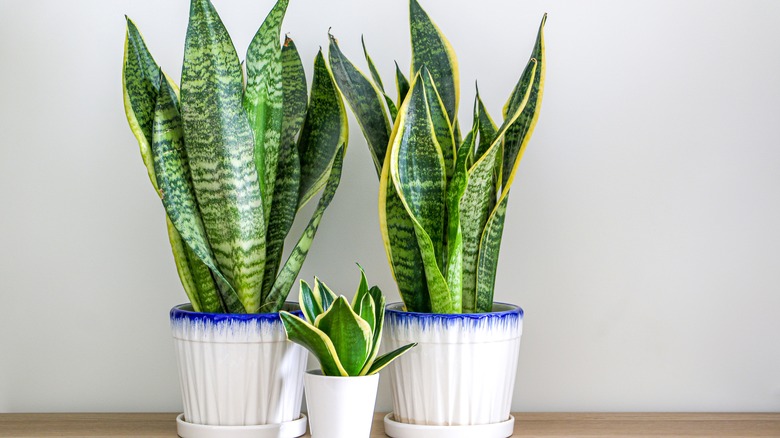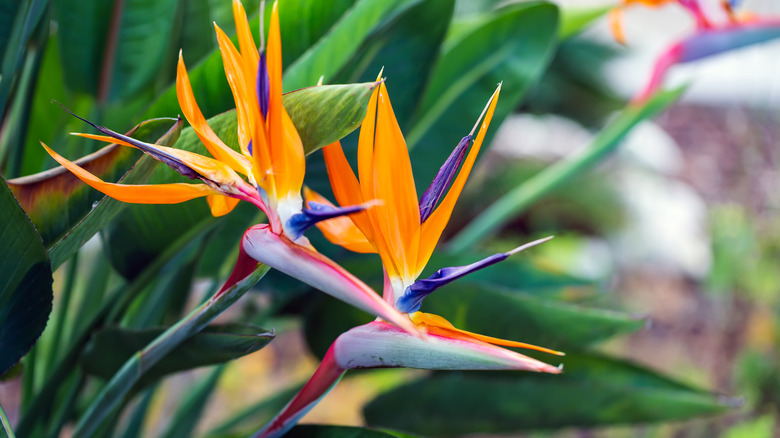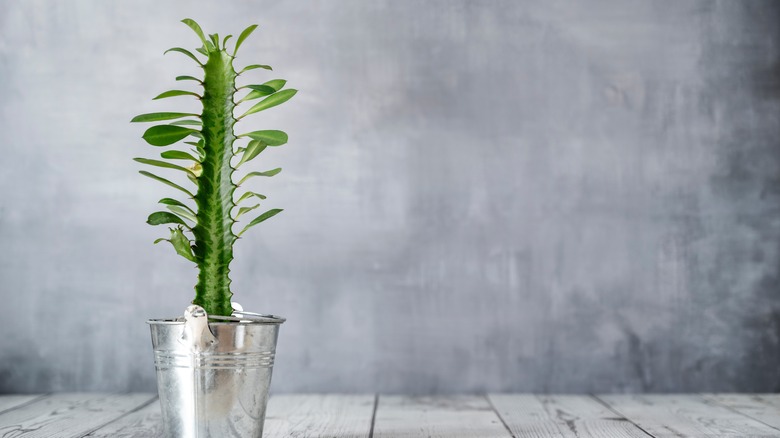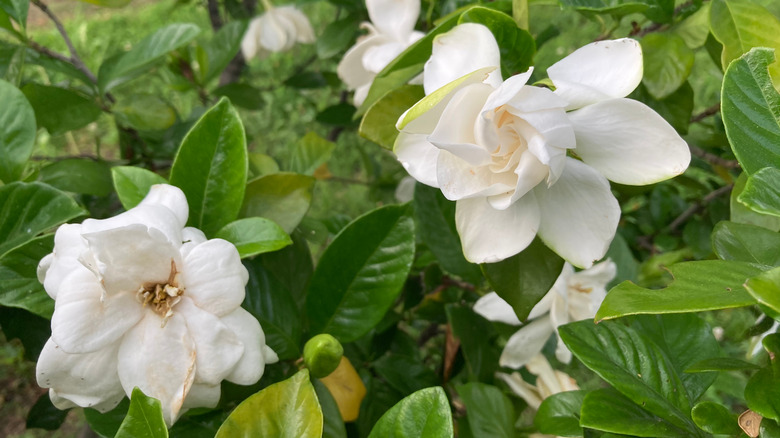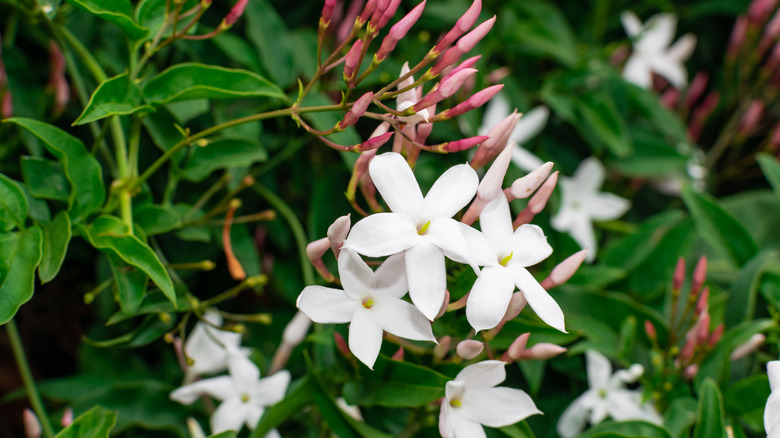15 Houseplants Perfect For A Sunny Balcony
If you love houseplants as much as we do, it's likely your home is overflowing with them. There are only so many windows in your house that can support the needs of sun-loving plants. Because of this, you may be considering moving a few of them outdoors, even though the process can be daunting, as described by The Sill. Or, perhaps you're looking for new indoor/outdoor plants to add to your collection. Either way, we can help.
There are many houseplants that do well indoors and outdoors. Whether you love cacti, tropical plants, or hardy flowering plants, we're sure that at least one of these 15 houseplants that are perfect for your sunny balcony will speak to you. So before you fall in love with another pothos or monstera, consider something out-of-the-norm that will turn your patio into a green forest of potted, hanging, or climbing plants. Just be sure you have the tools and supplies to care for the plants.
1. Hibiscus
Hibiscus (hibiscus rosa-sinensis) is a great plant to keep on your balcony during the summer. Most states are much too cold to grow hibiscus outdoors year-round, but by keeping yours in a container, you can move it to the sunniest spot with ease. No matter where you put it, be sure to keep its root ball consistently moist, as per Smithsonian Gardens.
Bloom Season: Spring and summer
USDA Growing Zone: 9 to 12
Growing Conditions: Full sun
Soil Type: Well-drained
Size: Up to 10 feet tall and 6 feet wide, but much smaller when container-grown
2. Aloe vera
Aloe vera (aloe barbadensis) does well in full sun outdoors when it is properly introduced to the light, as told by the University of Florida. When you move your aloe plant from dim indoor lighting to bright outdoor lighting, be sure to do so slowly to prevent sunburn. This drought-tolerant plant will appreciate hot summer days on your balcony.
Bloom Season: Late winter to spring
USDA Growing Zone: 8 to 11
Growing Conditions: Full sun to partial shade
Soil Type: Well-draining potting media
Size: Up to 2 feet tall
3. Papyrus
Papyrus (cyperus papyrus) is native to Africa, Madagascar, and the Mediterranean, where it grows nearby shallow bodies of water, explains the University of Wisconsin-Madison. As a houseplant, papyrus does well in containers filled with wet soil with no drainage holes. On your balcony, it should receive at least six hours of direct sunlight per day.
Bloom Season: Summer
USDA Growing Zone: 9 to 12
Growing Conditions: Full sun
Soil Type: Moist or wet growing medium
Size: 3 to 6 feet tall when grown ornamentally, dwarf varieties become 2 to 3 feet tall
4. Ponytail palm
Ponytail palms (Beaucarnea recurvata) are a popular choice for houseplant lovers. They are easy to care for because they are drought-tolerant, and they don't need high humidity, according to North Carolina State Extension. The most important thing to give a ponytail palm is bright direct sunlight which can easily be achieved from a sunny window or balcony.
Bloom Season: Spring and summer
USDA Growing Zone: 10 to 11
Growing Conditions: Full sun
Soil Type: Sandy and well-draining
Size: Less than 4 feet tall when container-grown
5. Croton
Croton plants (codiaeum variegatum) are known for their brightly colored foliage that may appear yellow, green, orange, red, purple, or pink, as explained by Missouri Botanical Garden. They also produce insignificant white flowers at different times during the year when they are grown outdoors. If you keep yours on your sunny balcony throughout the summer, you may be able to witness the croton's blooming period.
Bloom Season: Year-round
USDA Growing Zone: 11 to 12
Growing Conditions: Full sun to partial shade
Soil Type: Well-drained, fertile, and moist
Size: 2 to 6 feet tall and wide
6. Jade
Jade plants (crassula argentea) can be grown in containers all over your home as they tolerate full sun, partial shade, and full shade, says the University of Florida. They are adaptable, drought-tolerant plants that can be grown in poor and dry soil. The only things jade plants can't survive are cold temperatures and overwatering.
Bloom Season: Spring
USDA Growing Zone: 10 to 11
Growing Conditions: Full sun, partial shade, or full shade
Soil Type: Well-draining, sandy, loamy, or acidic
Size: 2 to 4 feet tall and 1 to 3 feet wide
7. Areca palm
The areca palm (dypsis lutescens) goes by several other names, including the butterfly palm and the bamboo palm, as told by North Carolina State Extension. Commonly grown as a houseplant in the United States, this medium-sized floor specimen needs bright light and high humidity to survive indoors or outdoors.
Bloom Season: Summer
USDA Growing Zone: 10 to 11
Growing Conditions: Full sun to part shade
Soil Type: Well-draining
Size: Up to 10 feet tall
8. String of pearls
The string of pearls plant (senecio rowleyanus) is an ornamental species native to South Africa. Usually, it is grown in hanging containers where its leaves and vines can cascade downward. Like Aloe vera, the string of pearls plants enjoy full sun, but they must be introduced to it slowly to prevent sunburns, according to the University of Wisconsin-Madison.
Bloom Season: Summer
USDA Growing Zone: 9 to 11
Growing Conditions: Full sun to part shade
Soil Type: Well-draining
Size: 1 to 3 feet long
9. Sago palm
Sago palms (cycas revoluta) are evergreen cycads that enjoy full sun, warm temperatures, and frequent watering, explains Missouri Botanical Garden. They are a good option for growing outdoors on a sunny balcony because they can grow quite tall, and they can withstand temperatures in the high teens for some time.
Bloom Season: Does not flower
USDA Growing Zone: 9 to 10
Growing Conditions: Full sun to part shade
Soil Type: Well-draining, sandy, or humusy
Size: 3 to 10 feet tall
10. Geranium
Geraniums (pelargonium spp.) are a good patio plant that will excite your home with some bright blossoms throughout the summer. As said by Gilmour, geraniums need weekly watering, full sun, and protection from the wind. When you provide them with proper care, your geraniums will thank you with mounds of gorgeous flowers.
Bloom Season: Late spring and summer
USDA Growing Zone: 9 to 12
Growing Conditions: Full sun
Soil Type: Free-draining
Size: 1 to 2 feet tall and wide
11. Snake plant
Snake plants (dracaena trifasciata) are related to several other popular houseplants such as corn plants, lucky bamboo, and Madagascar dragon trees, as described by Penn State Extension. The snake plant is low-maintenance and a good option for busy houseplant owners. It requires little water, some sun, and infrequent fertilization.
Bloom Season: Spring
USDA Growing Zone: 9 to 11
Growing Conditions: Bright indirect light
Soil Type: Cactus potting mix
Size: 6 inches to 3 feet tall depending on the variety
12. Bird of paradise
Bird of paradise plants (Strelitzia reginae) is named after the shape and color of their flowers which look like a bird's head. Though they do well in tropical garden beds, they are well-suited to growing in containers, as per Gardenia. They will enjoy growing on a sunny balcony as long as you can provide them with regular watering.
Bloom Season: Late winter to early spring
USDA Growing Zone: 10 to 12
Growing Conditions: Full sun to partial shade
Soil Type: Well-drained chalk, loam, or sand
Size: 5 to 6 feet tall and 3 to 4 feet wide
13. African milk bush
African milk bush plants (euphorbia trigona) may also be referred to as friendship cacti, candelabra cacti, or African milk trees, says Port St Lucie Botanical Gardens. This tall houseplant does well in sunny windows and even better on bright balconies. It should be watered frequently during the summer and slightly less often in the winter as it is only moderately drought-tolerant.
Bloom Season: Spring and summer
USDA Growing Zone: 10 to 11
Growing Conditions: Full sun and dappled shade
Soil Type: Well-draining
Size: 12 to 15 feet, but smaller when container-grown
14. Gardenia
Gardenia plants (gardenia jasminoides) can be difficult to grow, but their showy, fragrant flowers make your hard work worthwhile. This flowering shrub loves hot and humid environments that provide them with six or more hours of direct sunlight per day and consistently moist soil, as told by Gardenia.
Bloom Season: Late spring to fall
USDA Growing Zone: 6 to 11
Growing Conditions: Full sun and light shade
Soil Type: Organic, well-draining
Size: Up to 6 feet, smaller when container-grown
15. Jasmine
Jasmine (jasminum spp.) is another fragrant flower grown for its unique blossoms. It thrives in hanging baskets or pots, and it only needs some attention. Most jasmine cultivars require weekly watering, at least six hours of sunlight, and two hours of shade to grow healthily, explains Gilmour.
Bloom Season: Summer, spring, or winter depending on the cultivar
USDA Growing Zone: 7 to 10
Growing Conditions: Full sun and light shade
Soil Type: Well-draining, fertile and sandy or loamy
Size: 3 to 30 feet tall depending on the cultivar
